Danyang travel - South Korea, Asia
Danyang, a picturesque county in South Korea, is located in North Chungcheong Province and is known for its stunning natural landscapes and rich cultural heritage. Situated approximately 150 kilometers (93 miles) southeast of Seoul, nestled in a mountainous region that includes parts of Sobaeksan National Park. The area is characterized by its beautiful rivers, valleys, and limestone caves.
Danyang is renowned for its breathtaking scenery, particularly the Danyanggang River, which provides opportunities for outdoor activities like hiking, cycling, and water sports. The county is also famous for its Gosu Cave, a spectacular limestone cave featuring impressive stalactites and stalagmites.
Craving an exceptional South Korea adventure? Explore our handpicked premium tours here for the ultimate experience.
Population: Approximately 800,000 in 2024.
Economy: Danyang is a popular tourist destination known for its stunning natural landscapes, including mountains, rivers, and caves. Attractions like Gosu Cave and the Danyanggang River draw visitors, contributing significantly to the local economy through hospitality, dining, and recreational activities.
The region surrounding Danyang is characterized by agricultural activities, with local farms producing various crops. This agricultural base supports local markets and contributes to the food supply for the area.
Landmarks: Gosu Cave, Danyanggang River, Sobaeksan National Park, Danyang Wine Tunnel, Guinsa Temple, Ondal Gwangwangji
South Korea
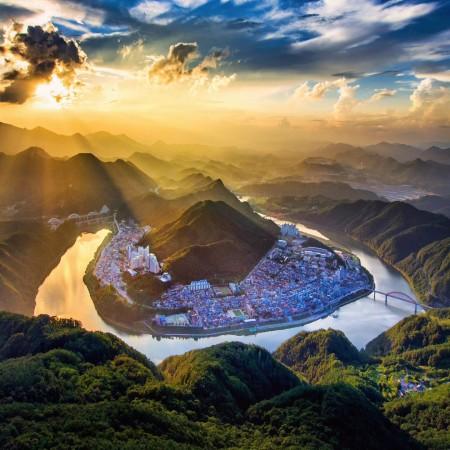
Overview of Danyang
History & Culture Influence
Danyang has been inhabited for centuries, with evidence of human activity dating back to prehistoric times. The region is known for its natural beauty, characterized by stunning landscapes, including the Sobaeksan Mountain and the Danyanggang River. Historically, Danyang served as a vital transportation hub, connecting various regions and facilitating trade and cultural exchange.
During the Joseon Dynasty, Danyang gained prominence as a center for education and culture, with the establishment of Confucian academies. The area is also noted for its traditional pottery, which has been a significant part of its cultural heritage. The Gosu Cave, one of the largest limestone caves in Korea, has historical importance as well, attracting visitors and researchers alike.
Danyang's culture is deeply intertwined with its natural environment. The city is famous for the "Eight Sights of Danyang," a collection of scenic spots that highlight the area's natural beauty. These sights have inspired poets and artists throughout history, contributing to Danyang's reputation as a cultural haven.
Interaction with The Locals
Predominantly composed of ethnic Koreans. The community is characterized by a mix of urban and rural residents, with many engaged in agriculture, tourism, and small-scale manufacturing. Locals in Danyang are known for their friendly and hospitable nature. Visitors often report positive interactions, with residents eager to share information about the area and its attractions. Danyang residents take pride in their rich cultural heritage and natural beauty. They are generally enthusiastic about showcasing local traditions, cuisine, and festivals to tourists, enhancing the visitor experience.
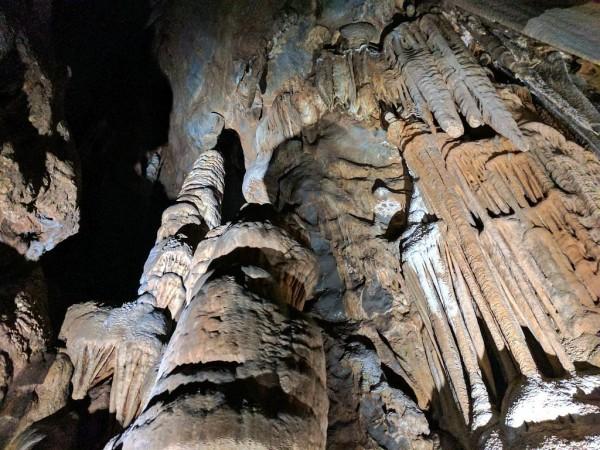
Gosu Cave, Danyang - © gather
Top Attractions in Danyang
Danyang is a hidden gem in South Korea, offering travelers a blend of breathtaking natural beauty and cultural richness. This charming town is surrounded by dramatic landscapes, including stunning river views, majestic mountains, and intriguing caves, making it a perfect destination for those seeking both adventure and tranquility. Whether you're exploring its scenic spots or immersing yourself in local traditions, Danyang promises an unforgettable experience.
Gosu Cave
Location: 8 Gosudonggul-gil, Danyang-eup, Danyang-gun, Chungcheongbuk-do, South Korea
Known as the "Underground Palace," Gosu Cave features stunning limestone formations with impressive stalactites and stalagmites. Its multi-level structure, formed over millions of years, attracts nature lovers and adventure seekers alike.
Danyanggang River
Location: situated 1.2-kilometer-long trekking path along the Namhangang River Danyang, Chungcheongbuk-do
The Danyanggang River is celebrated for its picturesque scenery and array of recreational activities. Kayaking, fishing, and cycling along the riverbanks are popular, offering visitors a chance to immerse themselves in the natural beauty of the area.
Sobaeksan National Park
Location: Sobaeksan-ro, Danyang-gun, Chungcheongbuk-do, South Korea
Sobaeksan National Park boasts stunning mountain landscapes, extensive hiking trails, and a rich diversity of flora and fauna. The park becomes a particularly popular destination in autumn when the foliage turns vibrant, providing breathtaking views for hikers.
Guinsa Temple
Location: 73 Guinsa-gil, Yeongchun-myeon, Danyang-gun, Chungcheongbuk-do
Guinsa Temple stands as a significant Buddhist site, known for its exquisite architecture and tranquil atmosphere. The complex offers insights into Korean Buddhist practices and provides a serene space for meditation and reflection.
Ondal Gwangwangji
Location: 23, Ondal-ro, Danyang-eup, Danyang-gun, Chungcheongbuk-do, South Korea
Linked to the legendary figure Ondal, this site features a park and various monuments, celebrating stories of love and bravery. It's a cultural landmark for those interested in Korean historical narratives.
Suyanggae Light Tunnel
Location: 390 Suyanggae-gil, Danyang-eup, Danyang-gun, Chungcheongbuk-do, South Korea
The Suyanggae Light Tunnel is a vibrant venue known for its artistic light displays. It's a favorite for photography enthusiasts and visitors looking for a picturesque stroll through colorful lights.
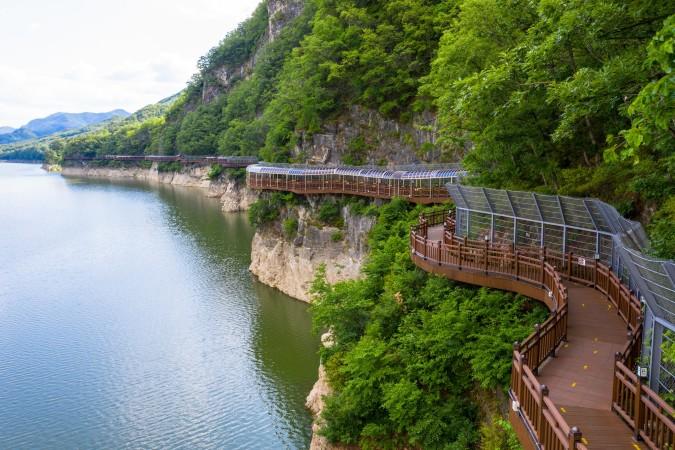
Danyanggang River trail - © gather
Must-Try Dishes in Danyang
Danyang’s culinary scene is a delightful journey into traditional Korean flavors, offering dishes that reflect the region’s agricultural richness and deep-rooted food culture. Visitors can savor hearty, local specialties that highlight fresh, seasonal ingredients, providing an authentic taste of rural Korea. Whether you're indulging in a comforting stew or enjoying unique local delicacies, Danyang’s cuisine is sure to leave a lasting impression.
Ssogari Meungtang (Spicy Mandarin Fish Stew)
A hearty stew is prepared with mandarin fish simmered in a spicy broth alongside various vegetables and spices, offering a rich flavor profile. It's especially popular during the colder months. Ssogari Meungtang is celebrated as a local delicacy in Danyang, highlighting the region's access to fresh fish and its tradition of using local ingredients to create comforting, flavorful dishes.
Danyang Garlic Chicken
Fried chicken is generously coated with crispy fried garlic, adding a robust flavor that is loved by both locals and visitors. The dish celebrates Danyang's renowned high-quality garlic, which flourishes in the region's unique climate and soil, thereby emphasizing the town's agricultural heritage.
Garlic Tteok-galbi (Grilled Short Rib Patties)
These grilled patties are made from minced short ribs mixed with garlic and other seasonings, resulting in tender and flavorful bites typically served with rice and side dishes. The incorporation of garlic in tteok-galbi showcases Danyang’s culinary identity and underscores garlic’s pivotal role in local cooking.
Danyang Noodles
Crafted with garlic, these noodles are served in a light broth or stir-fried with vegetables, known for their chewy texture and subtle garlic flavor. Danyang noodles exemplify the utilization of regional agricultural products, particularly garlic, offering a simple yet profoundly satisfying culinary experience.
Black Garlic Fried Chicken (Gangjeong)
This dish features bite-sized pieces of fried chicken glazed in a dark black garlic sauce and often served with nurungji (crispy rice). The sweet and savory flavor of black garlic adds a unique twist to the traditional fried chicken, reflecting Danyang’s innovative spirit in blending traditional recipes with local ingredients.
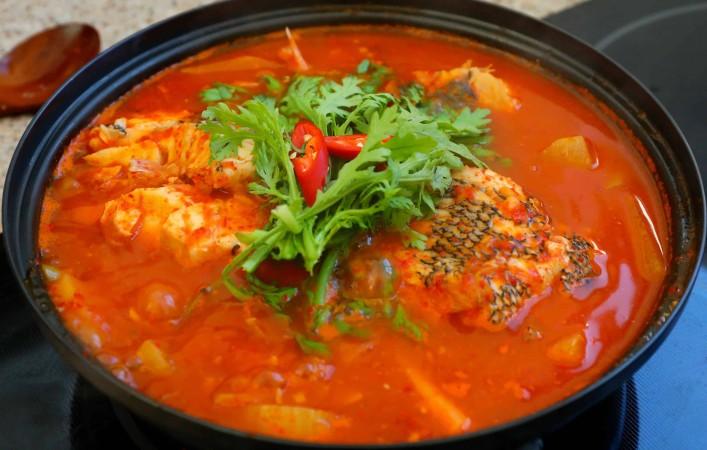
Ssogari Meungtang - © gather
Festivals & Local Celebrations
Sobaeksan Royal Azalea Festival
Time of Year: May
Celebrate the blooming of royal azaleas at Sobaeksan National Park during this vibrant festival. Visitors can admire the stunning pink flowers, enjoy cultural performances, and participate in outdoor activities like hiking and camping.
Twins Healing Festival
Time of Year: June
This unique festival honors the special bond between twins. Attendees can enjoy twin-themed performances, engage in various games and activities, and explore the cultural significance of twins in Korean folklore.
Danyang Ondal Festival
Time of Year: September
The Ondal Festival commemorates the legendary figure Ondal, celebrated for his love story and acts of bravery. The festival features traditional performances, cultural events, and invites visitors to wear traditional Korean costumes to enhance their experience.
Danyang Makgeolli Festival
Time of Year: October
This festival highlights Danyang's local specialty, makgeolli, a traditional Korean rice wine. Participants can taste various makgeolli varieties, enjoy live music, cultural performances, and discover the history and craft behind this beloved beverage.
Danyang Light Festival
Time of Year: November-December
Experience the magical transformation of Danyang during the Light Festival in the winter months. Visitors can wander through beautifully illuminated trails, admire creative light installations, and soak in the festive atmosphere, making it an ideal time to visit the area.
Looking to add more adventure to your journey? Gwangju awaits with unique experiences—explore more here.
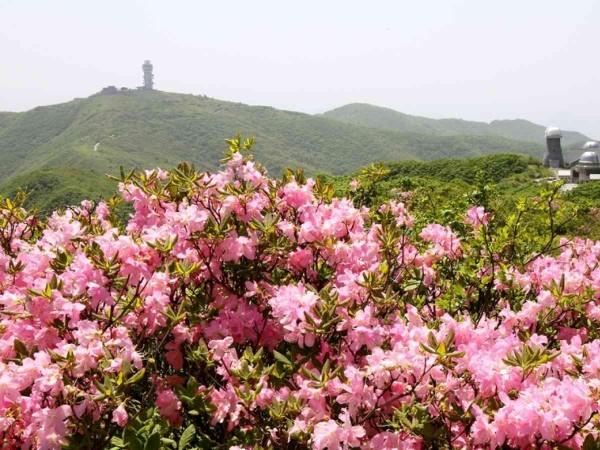
Sobaeksan Royal Azalea Festival - © gather
What to Do in Danyang
Paragliding
Danyang is renowned for its excellent paragliding opportunities, providing breathtaking views of the surrounding mountains and valleys. Visitors can soar above the landscape, experiencing the thrill of flight while enjoying the stunning scenery.
Gosu Cave
Known as one of the largest limestone caves in Korea, Gosu Cave features impressive stalactites and stalagmites. Guided tours allow visitors to explore the cave's fascinating geological formations and learn about its history.
Curious about the scenic beauty of Jeonju? Find out what makes it so special here in our in-depth travel guide.
Macheonha Sky Walk and Zipline
This skywalk offers visitors a thrilling experience as they walk along a glass-bottomed path suspended high above the ground, providing panoramic views of the surrounding landscape. A zipline is also available for those seeking an adrenaline rush.
Dodamsambong Peaks
An iconic rock formations rise dramatically from the river, making for a picturesque spot for photography and leisurely walks. The area is steeped in local legend, adding cultural significance to the natural beauty.
Guinsa Temple
This significant Buddhist temple is known for its beautiful architecture and serene atmosphere. Visitors can explore the temple grounds, participate in meditation sessions, and learn about Korean Buddhism.
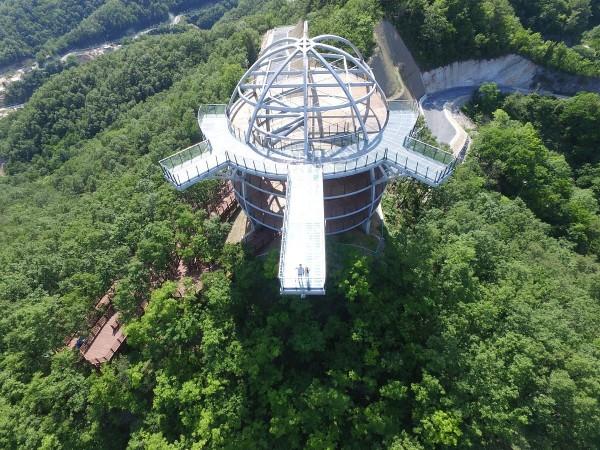
Macheonha Sky Walk - © gather
Weather in Danyang
Average Temperatures
Summer (June to August): Average daily highs range from 26°C to 30°C (79°F to 86°F) with lows around 18°C to 22°C (64°F to 72°F).
Winter (December to February): Average daily highs are between 2°C and 7°C (36°F to 45°F) with lows dropping to -6°C to -2°C (21°F to 28°F).
Spring (March to May) and Fall (September to November): Temperatures are mild, with highs typically between 10°C and 21°C (50°F to 70°F) and lows ranging from 3°C to 16°C (37°F to 61°F).
Rainfall
Annual Rainfall: Danyang receives approximately 1,200 to 1,800 mm (47 to 71 inches) of precipitation per year.
Rainy Season: The wettest months are July and August, with significant rainfall, often exceeding 150 mm (6 inches) in these months.
Dry Season: January to April typically sees less rainfall, with January being the driest month.
Best Time to Travel
Spring (April to May): Known for pleasant weather, blooming flowers, and low rainfall, making it ideal for outdoor activities.
Fall (September to October): Offers mild temperatures and beautiful autumn foliage, providing a picturesque backdrop for visitors.
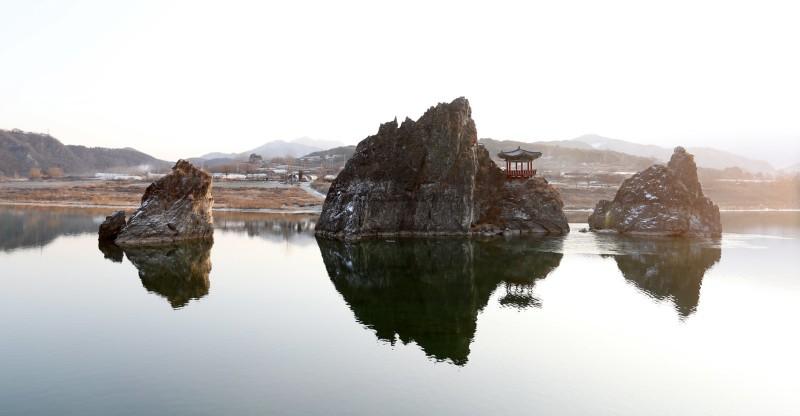
Dodamsambong Peaks - © JEON HAN
Essential Travel Information
Getting to Danyang
Airport Transfers
Incheon International Airport (ICN) and Gimpo International Airport (GMP) are the primary airports serving Danyang. While some hotels may not provide direct airport transfer services, visitors can utilize shuttle buses or private taxi services to reach Danyang from the airports.
Bus Services
There are express bus services from major cities like Seoul and Daegu to Danyang. Buses typically depart from bus terminals in these cities and provide a comfortable and efficient way to travel to Danyang.
Getting Around Danyang
Public Transit
Danyang has a reliable public bus system that connects various neighborhoods and attractions. Buses are affordable and operate frequently, making them a convenient option for getting around the city.
Taxis
Taxis are widely available in Danyang and can be hailed on the street or booked via phone. Fares are metered, and they provide a comfortable option for direct transfers to specific destinations.
Ride-Sharing Services
Ride-sharing services like KakaoTaxi are available in Danyang, allowing travelers to book rides through mobile apps. This option offers flexibility and convenience for getting around the city.
ATM and Banking Services
- ATMs: Danyang has several ATMs that accept international cards, including Visa and Mastercard. Visitors can find ATMs at major banks and convenience stores throughout the city. It's advisable to try multiple machines if one does not work, as some may have restrictions on foreign cards.
- Banks: Major banks such as Shinhan Bank and Woori Bank have branches in Danyang, offering a range of banking services, including currency exchange and cash withdrawals.
Accommodation Choices
SONO MOON DANYANG
A well-rated hotel offering modern amenities and beautiful views of the surrounding mountains. It is conveniently located near popular attractions.
Danyang Bihaenggi
A comfortable accommodation option that provides essential amenities for travelers. It is suitable for those looking for a budget-friendly stay.
Daemyung Resort Danyang
A resort offering a range of facilities, including a spa, golf course, and various recreational activities. It is ideal for families and those looking for a relaxing getaway.
Local Guesthouses and Motels
Danyang also features various guesthouses and motels that cater to budget-conscious travelers. These accommodations often provide a more intimate experience and a chance to connect with local culture.
Articles for you

Experience Aboard The RV Indochine II - A Mekong Cruise With Tweet World Travel
The RV Indochine II is a luxury river cruise ship, offering an unforgettable journey through many attractions along the Mekong River. Built in 2017, this upscale vessel combines colonial elegance with modern conveniences to create a comfortable yet stylish environment for its crew and passengers. The ship’s intimate size makes it ideal for those seeking a more personal cruising experience while exploring Vietnam and Cambodia rich culture, scenery, and heritage. Whether you're gazing at the landscape from your private balcony or enjoying authentic local cuisine, RV Indochine II promises an exotic adventure like no other.

Witness Stilt Fishing In Sri Lanka: An Eco-Tourism Experience
Sri Lanka, renowned for its stunning beaches and rich cultural heritage, harbors a unique tradition that has captivated travelers for centuries: stilt fishing. This ancient practice, passed down through generations of coastal communities, blends artistry with necessity, offering a glimpse into a way of life intimately connected to the island's coastal rhythms. Stilt fishing in Sri Lanka isn't merely a means to catch fish; it's a cultural emblem, embodying the resilience and ingenuity of Sri Lanka's fishing communities.

Make Your Trip Stress-Free With The Tweet Trip App
Embark on your next adventure with confidence by downloading the Tweet Trip App, available for both iOS and Android. This essential travel companion allows you to view your detailed itinerary, stay connected with your tour guide and fellow travelers, receive real-time updates, and provide feedback effortlessly. With features like in-app messaging, emergency assistance, and location sharing, the Tweet Trip App ensures you travel smarter, stay connected, and enjoy a seamless, worry-free journey. Get started today and make the most of your travel experience with Tweet World Travel.

Pedal Through Paradise: Unveiling Cambodia's Hidden Gems on Two Wheels
The gentle whir of bicycle wheels mingles with the distant chants of monks as you glide past emerald rice paddies stretching to the horizon. This is Cambodia - a sensory explosion waiting to be experienced on two wheels. At Tweet Tours, we believe there's no better way to immerse yourself in the Kingdom of Wonder than by bicycle.
Cambodia isn't just a destination; it's a living, breathing tapestry of ancient wonders, natural beauty, and vibrant culture. Our carefully crafted cycling tours take you beyond the typical tourist haunts, offering a unique perspective on this captivating country. Ready to clip in and discover the magic of Cambodia? Let's ride!

Trekking in the Himalayas: A Journey Through Nepal's Majestic Peaks
The Himalayas rise from the earth like colossal guardians, their snow-capped peaks piercing the sky in a display of nature's raw power and beauty. Nepal, nestled at the heart of this mountain range, serves as the gateway to some of the most breathtaking trekking experiences on the planet. Here, the air is crisp and thin, filled with the promise of adventure and the whispers of ancient tales.
With Tweet Tours, as you set foot on these hallowed trails, you're not just a traveler - you're a modern-day explorer, following in the footsteps of legendary mountaineers and age-old traders. Each step takes you further into a world where nature reigns supreme and human resilience is tested against the backdrop of some of the world's highest peaks.
From the moment your boots touch the ground in Kathmandu, you'll feel the pull of the mountains. The bustling streets of the capital, with their sensory overload of sights, sounds, and smells, soon give way to serene mountain paths where the only soundtrack is the crunch of gravel underfoot and the distant tinkling of yak bells.

Exploring Mui Ne's Wonders: Unique Attractions & Local Dishes
Nestled along the southeastern coast of Vietnam, Mui Ne emerges as a captivating gem, blending natural wonders with cultural richness. Renowned for its stunning landscapes and unique attractions, Mui Ne beckons travelers seeking both relaxation and adventure in equal measure. Mui Ne's renowned beach dunes, bustling fishing towns, and excellent local food await exploration at every turn.
The allure of Mui Ne lies not only in its pristine beaches and crystal-clear waters but also in its diverse range of activities catering to every traveler's whims. Whether you're drawn to thrilling water sports like kitesurfing and windsurfing on its dynamic shores or seeking tranquility amidst the picturesque Fairy Stream, Mui Ne promises an unforgettable journey filled with discovery.
